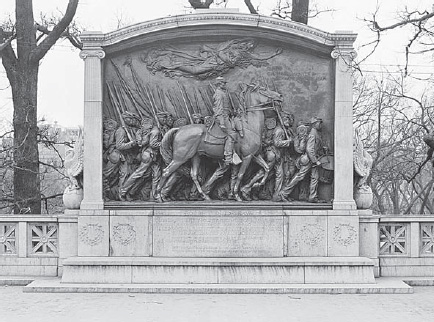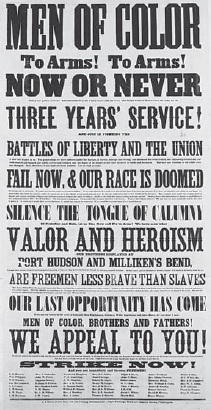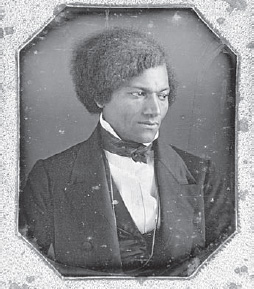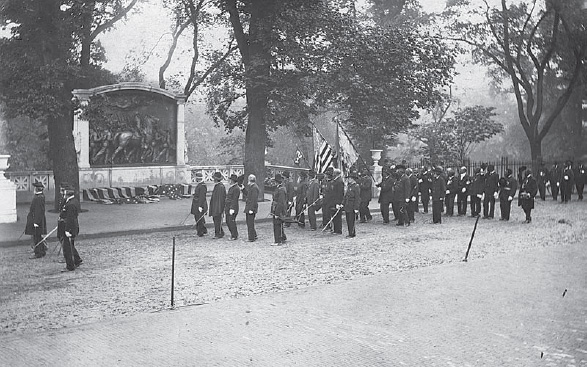
The Battleground over Public Memory
A WAR MEMORIAL MIGHT be viewed as a peculiar symbol of social justice, but the Shaw Memorial in Boston is precisely that. The Shaw Memorial honors the 54th Massachusetts Regiment, a regiment of African American soldiers who had to fight to be allowed to join the Union armies during the Civil War. The memorial, unveiled in 1897, sits across from the Massachusetts State House on Beacon Street and features Col. Robert Gould Shaw on horseback with twenty-three black soldiers from his regiment marching beside him.

Augustus Saint-Gaudens, the Shaw Memorial, 1884–1897, Boston Commons (LC-D4-90157, Library of Congress)
The monument symbolizes how black soldiers helped shift the objective of the Civil War from preserving the Union to ending slavery by force. For more than a century, the Shaw Memorial carried this message through decades of white supremacy, Jim Crow laws, and the suppression of the historical memory of the pivotal role of African American soldiers in the war.1 The Shaw Memorial was unveiled two decades after the collapse of Reconstruction, one year after the Plessy v. Ferguson Supreme Court decision, and during the height of Confederate Lost Cause propaganda. It was one of thousands of soldier monuments built after the war, nearly all of which whitewashed the role of black soldiers and ignored the issue of slavery. At stake was control over public memory and the meaning of the Civil War. Cast in bronze, the Shaw Memorial asserted a powerful countermessage. It asserted that the root cause of the war was slavery and the outcome of the conflict was its abolition. It stood as a symbol of racial justice and reasserted an emancipation narrative into the landscape and the contested terrain of public memory.
Recruiting Black Soldiers
From the outset of the Civil War, the abolitionist community had fought to define the meaning of the Civil War during and after the conflict. On March 2, 1863, Frederick Douglass, the ex-slave, author, renowned orator, and abolitionist, published a broadside “Men of Color, to Arms!” that began with the following appeal:
When first the Rebel cannon shattered the walls of Sumter and drove away its starving garrison, I predicted that the war then and there inaugurated would not be fought out entirely by white men. Every month’s experience during these two dreary years has confirmed that opinion. A war undertaken and brazenly carried on for the perpetual enslavement of colored men, calls logically and loudly upon colored men to help suppress it.2
Douglass’s appeal had arisen out of his frustration with black soldiers being denied the opportunity to enlist in the Union armies from 1860 to mid-1862.3
Abolitionists knew that as long as blacks were barred from fighting in the war, the issue of defeating slavery would be marginalized. Abolitionists consistently pressured Lincoln to do more. They urged him to frame the Union cause around defeating slavery, and they urged him to add provisions to the final Emancipation Proclamation that would allow blacks to join the Union armies. When the opportunity to form black regiments in Massachusetts finally presented itself, abolitionists became the key recruiters.4
Massachusetts governor John A. Andrew (1861–1866), a fervent abolitionist supporter, and George L. Stearns, a businessman who had helped finance John Brown’s failed raid at Harpers Ferry, led the efforts to form the 54th. Key recruiters who reached out to potential recruits included Frederick Douglass (who helped recruit more than one hundred soldiers, including his sons, Lewis and Charles); Rev. Samuel Harrison (who later became the chaplain of the 54th); Henry Highland Garnett; Martin R. Delany; and T. Morris Chester, to name a few.
Recruiting tactics included visual appeals. Frederick Douglass’s broadside “Men of Color, to Arms!” called on black men throughout the North to come to Massachusetts and to enlist—an appeal that connected their struggle to those in the past who had combated slavery with force: “Remember Denmark Vesey of Charleston. Remember Nathaniel Turner of South Hampton; remember Shields, Green, and Copeland, who followed noble John Brown, and fell as glorious martyrs for the cause of the slaves . . . This is our golden opportunity.”5
Douglass’s words found their way onto other broadsides. A recruiting poster in Pennsylvania featured his slogan “Men of Color, to Arms!” in bold text, along with the added slogans “Now or Never,” “Fail Now, & Our Race is Doomed,” and “Are Freemen Less Brave Than Slaves.” These slogans did not mince words. They pronounced the war as the singular opportunity to end slavery and suggested that free black men who failed to enlist would be considered cowards.

Men of Color, to Arms!, broadside, 1862 (Library Company of Philadelphia)
This recruiting drive was successful, as 1,007 black soldiers and 37 white officers signed up for the 54th from across the North and the South. Four percent of the regiment hailed from Massachusetts (133 men), 294 recruits came from Pennsylvania, 183 from New York, 155 from Ohio, 64 from Michigan, and the rest from other states. Thirty-seven men listed their residency in slave states and 30 of these men had once been held in slavery.6 Chosen to lead the regiment was twenty-six-year-old Col. Robert Gould Shaw, Harvard educated and a person of privilege, whose family was part of the New York and Boston abolitionist communities.
![]()
The 54th, however, continued to face barriers of discrimination that prevented them from actually fighting. When the regiment arrived in South Carolina they were assigned to menial labor, digging trenches and other tasks that fell outside of combat. Shaw and his men protested. Shaw lobbied Governor Andrew and his superiors to allow his regiment to fight, and on July 16 this request was granted when the 54th fought bravely in skirmishes on James Island, outside Charleston.
Two days later, the 54th would again see combat in a battle that defined their legacy. On July 18, 1863, the 54th led a nighttime charge on Fort Wagner (a Confederate battery on Morris Island, South Carolina) that would turn into a slaughter. The well-defended fort easily repelled the assault by the 54th and other Union regiments that followed. Shaw was shot in the chest and killed when he scaled the side of the battery. His regiment was decimated; 274 men were killed, wounded, or captured out of the 600 members of the 54th assigned to storm the fort.
Although defeated on Morris Island, the extraordinary courage exhibited by the 54th earned black soldiers the respect of the military and led to an increase in other black regiments being deployed to combat situations. Black soldiers eventually accounted for 10 percent of the total number of Union soldiers, an increase in military strength that helped the Union armies deliver the final blow to the Confederacy and slavery. And when the war ended, black soldiers and the abolitionist community had to fight another battle: the battle over the meaning of the Civil War and its root cause.
“If war among the whites brought peace and liberty to the blacks, what will peace among the whites bring?”
—Frederick Douglass, July 5, 18757
Following the Civil War, the South was occupied by federal troops to ensure that ex-slaves were granted their freedom. Three Constitutional Amendments were passed between 1865 and 1870: The Thirteenth Amendment that outlawed slavery, the Fourteenth Amendment that guaranteed citizenship rights to all persons born or naturalized in the United States, and the Fifteenth Amendment that granted voting rights to men regardless of “race, color, or previous condition of servitude.” A Freedmen’s Bureau was also established that provided food, medical care, schools, and other services to ex-slaves.
However, Reconstruction was bitterly contested. President Andrew Johnson (1865–1869), a self-avowed white supremacist, repeatedly vetoed Reconstruction measures. He encouraged Southern states to enact black codes that would curb black political rights and restrict their economic opportunities. He also overruled the Freedmen’s Bureau plan to redistribute small portions of land from slave masters to former slaves.
Reconstruction collapsed in 1877, when Republican politicians sold out the civil and political rights of African Americans when they agreed to remove federal troops from the South in return for electoral commission votes for the Republican Rutherford B. Hayes in the disputed Tilden-Hayes presidential election. This ensured that equal protection guaranteed by the Fourteenth Amendment all but disappeared, ushering in black disenfranchisement and labor conditions that equated to peonage.
Black civil liberties were also attacked on the cultural front. White Southerners viewed themselves as victims. The white South reeled from the physical destruction of the war, the trauma of defeat, the occupation by federal troops, and the federally imposed measures. In response, a “Lost Cause” ideology painted the Confederate war effort as heroic, one that fell short only because of lack of military might. Worse, it portrayed the 250-plus years of slavery in the South as genteel and slaves as content and faithful to their masters.
This racist ideology sought to assert political power for Southern whites by rewriting the historical past and by attacking the gains made by African Americans during Reconstruction. From 1867 to the mid-twentieth century the Lost Cause ideology caught fire across the United States and was disseminated by well-organized groups, including the United Daughters of the Confederacy (UDC) and the United Confederate Veterans (UCV), who published countless books, organized speaking tours, and influenced the rewriting of school textbooks that reflected a Lost Cause stance. Additionally, these groups, led by elite white women, erected thousands of monument campaigns that codified a Lost Cause reading of the war in towns and cities across the South and the North. “In late 1895, in Fort Mill, South Carolina,” writes David W. Blight, “a hundred miles or so inland from Battery Wagner (where originally a plan had existed to build a memorial to Shaw), a monument to the ‘faith and loyalty’ of the southern slave in the war was erected.”8 This was only the beginning.
From 1905 to 1925 the UDC organized a campaign to erect “mammy” memorials in every state—monuments to “loyal” African American women who took care of their slave masters’ children. The UDC lobbied Congress for a national mammy memorial in Washington, DC, to be erected on Massachusetts Avenue, near Sheridan Circle. The appropriation for the monument passed the U.S. Senate in 1922 but failed in the House of Representatives and was never built, but it did signify just how pervasive the Lost Cause ideology had become.

Frederick Douglass, ca. 1848, daguerreotype (Chester County Historical Society, West Chester, PA)
Black leaders and their allies, aghast at how the gains of Reconstruction were being dismantled one by one, spoke out against the barrage of Lost Cause propaganda. Frederick Douglass constantly addressed the attacks on Civil War memory and the climate of reconciliation and forgetting. He described the American public as “destitute of political memory.”9 In speech after speech he reminded his audience about the root cause of the Civil War and its moral outcome. In NYC in 1878, Douglass stated, “It was a war of ideas, a battle of principles . . . a war between the old and new, slavery and freedom, barbarism and civilization.”10 Douglass knew that those who controlled the memory of the war could shape the country’s future. He also knew that the sacrifices of 180,000 black soldiers (37,000 of whom died during the war) and the mass carnage of the war (the death of 618,000 to 750,000 soldiers) would be in vain if black citizenship and civil rights were not protected.
A Monument to Emancipation
The Shaw Memorial offered a ray of hope. It portrayed the black freedom struggle during the Civil War and acted as a countermemorial to the barrage of Lost Cause ideology.11 From its inception, both blacks and whites worked together on its concept. In 1863, almost immediately after Shaw’s death at Fort Wagner, the call for a monument dedicated to him came from his own men. Despite the fact that the soldiers, along with Shaw, had not been paid for more than a year and a half (as part of a protest against the unequal salary rates that black soldiers received compared to their white counterparts) the regiment began the process of raising funds for a memorial to their fallen commander.12
In Boston, the vision of a memorial to Shaw also begun to take root shortly after the story of Fort Wagner became widespread. Joshua B. Smith, a prominent black abolitionist and friend to the Shaw family, spearheaded the project and brought in the Massachusetts senator Charles Sumner and Governor Andrew to help raise funds and form a committee to select an artist. The committee decided upon a local sculptor, William Wetmore Story.
Story was the first of four white artists who would be rejected due to a host of problems, including diminished funding and controversies over the proposed designs. Each of these artists presented drawings and models for a potential memorial focusing exclusively upon Shaw on horseback with no reference to the soldiers who served under him.
When the committee selected Augustus Saint-Gaudens in 1882, its fifth candidate, he too proposed a monument that emphasized Shaw on horseback, but the large sculpture set within an arch also included three relief tablets near the base that presented at least fleeting evidence of the regiment. The relief section depicted the 54th leaving Boston, storming Fort Wagner, and in the final panel, the survivors of the regiment returning from war. The design, however, was also rejected. The most stinging criticism came from the Shaw family, who said the equestrian pose “seemed pretentious” and excessive for their son, whose rank of colonel did not merit such a grandiose statue.13
More important, the Shaw family resisted the notion that their son was more significant than the troops he commanded. When Shaw had been killed at Fort Wagner, Confederate soldiers had thrown his body into a large unmarked grave with the other Union soldiers who had died during the battle. This action, burying a colonel with the common soldier, and a white commanding officer with black soldiers, was done out of spite, as a way to show Shaw the ultimate disrespect. The Shaw family viewed the action differently: they believed that their son should be, and would have wanted to be, buried with his men.

Augustus Saint-Gaudens, the Shaw Memorial (detail), 1884–1897, Boston Commons (photograph courtesy of Michael Lampert)
To the Shaw family, the monument proposals that either excluded or greatly diminished the importance of black troops were examples of the racism that they abhorred. The family had been part of the abolitionist movement, and was not willing to let the significance of the black soldiers in the war become dismissed and forgotten.
A new design by Saint-Gaudens provided a solution that the Shaw family deemed acceptable. Kirk Savage explains that Saint-Gaudens
devised a solution that would integrate into one image the two separate elements of the 1882 design. The sculptor hit upon the idea of representing an infantry march with Shaw on horseback and his soldiers on foot, the whole scene in one large relief panel. In this way the commemorative content shifted further, as Shaw and the troops now melded into one sculptural statement.14
Showing the regiment marching in a profile view, Saint-Gaudens depicted the moment in which the 54th departed from Boston on May 28, 1863, en route to Boston Harbor, from where they would then travel by sea to South Carolina.
Saint-Gaudens viewed the new composition as an aesthetic challenge, one that would cement his legacy as one of the most renowned sculptors of his day. He was neither an abolitionist nor particularly connected to the Boston community or its history.15 His concerns were for the formal elements of art and classical realism. His desire to sculpt Shaw and the black soldiers in a realistic manner proved to be the saving grace of the memorial.
![]()
On May 31, 1897, a massive crowd of approximately 3,500 cadets, seamen, policemen, and spectators attended the dedication of the Shaw Memorial.
Present also were 140 survivors of the 54th, the 55th, and the 5th Cavalry. Following the dedication, the event segued to the Boston Music Hall. Two keynote speakers addressed the crowd; William James, the noted Harvard philosophy professor whose brother had been an officer in the 54th and was badly wounded at Fort Wagner, and Booker T. Washington, the charismatic and controversial African American leader and head of the Tuskegee Institute in Alabama.
James complimented the monument for focusing attention on the Civil War as a battle to end slavery, and remarked that it served as a contrast to the common soldier monuments that lulled Americans into forgetting the “profounder meaning of the Union cause.”16 Booker T. Washington’s speech took a different angle. Washington, who was much maligned by other black leaders, most notably by W.E.B. Du Bois, for accommodating white supremacy by not demanding full equal rights for African Americans, stayed true to form and addressed the need for reconciliation between the North and South and the black and white populations. He urged both races to put aside their hate:
Until that time comes, this monument will stand for effort, not victory complete. What these heroic souls of the 54th Regiment began, we must complete. It must be completed not in malice, nor narrowness, nor artificial progress, nor in efforts at mere temporary political gain, nor in abuse of another section or race. Standing as I do to-day in the home of Garrison and Phillips and Sumner, my heart goes out to those who wore the gray as well as to those clothed in blue, to those who returned defeated to destitute homes, to face blasted hopes and a shattered political and industrial system. To them there can be no prouder reward for defeat than by a supreme effort to place the negro on that footing where he will add material, intellectual, and civil strength to every department of state.17

James H. Smith and William J. Miller, dedication of the Memorial to Robert Gould Shaw and the 54th Massachusetts Regiment, Boston, May 31, 1897 (Massachusetts Historical Society)
In the audience sat many veterans of the 54th Regiment. When Washington referred to Sgt. William H. Carney, he stood up and raised the same flag that he had carried at Fort Wagner. The emotions of the event were so intense that Washington later highlighted the event in his book Up from Slavery:
It has been my privilege to witness a good many satisfactory and rather sensational demonstrations in connection with some of my public addresses, but in dramatic effect I have never seen or experienced anything which equaled this. For a number of minutes the audience seemed to entirely lose control of itself.18
The sculptor Augustus Saint-Gaudens was also in the audience. Perhaps he left changed after witnessing the events of the dedication unfold. Reflecting on the veterans of the 54th reenacting the march down Beacon Street, Saint-Gaudens later wrote, “The impression of those old soldiers, passing the very spot where they left for the war so many years before, thrills me even as I write these words. . . . They faced and saluted the relief, with the music playing ‘John Brown’s Body,’ a recall of what I had heard and seen thirty years before. . . . It was a consecration.”19
Richard Throssel, Sees with His Ears—Crow, ca. 1905–1911 (Richard Throssel Collection, American Heritage Center, University of Wyoming)